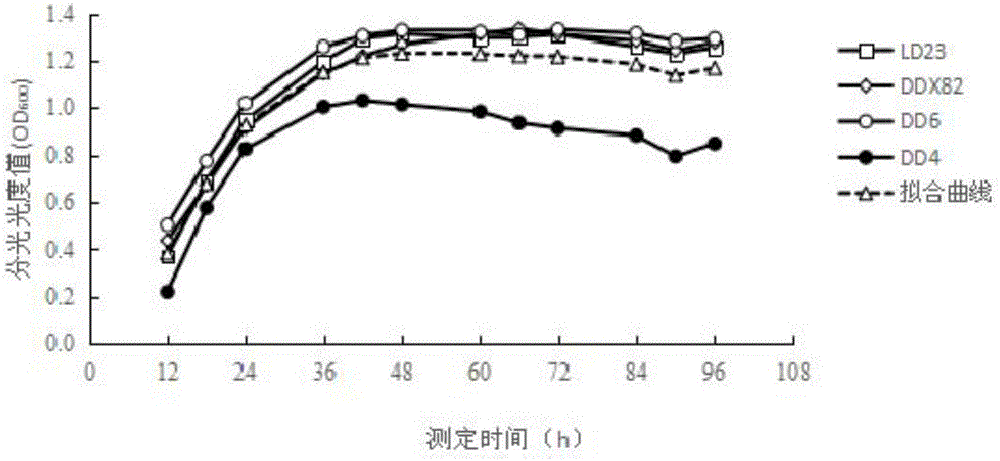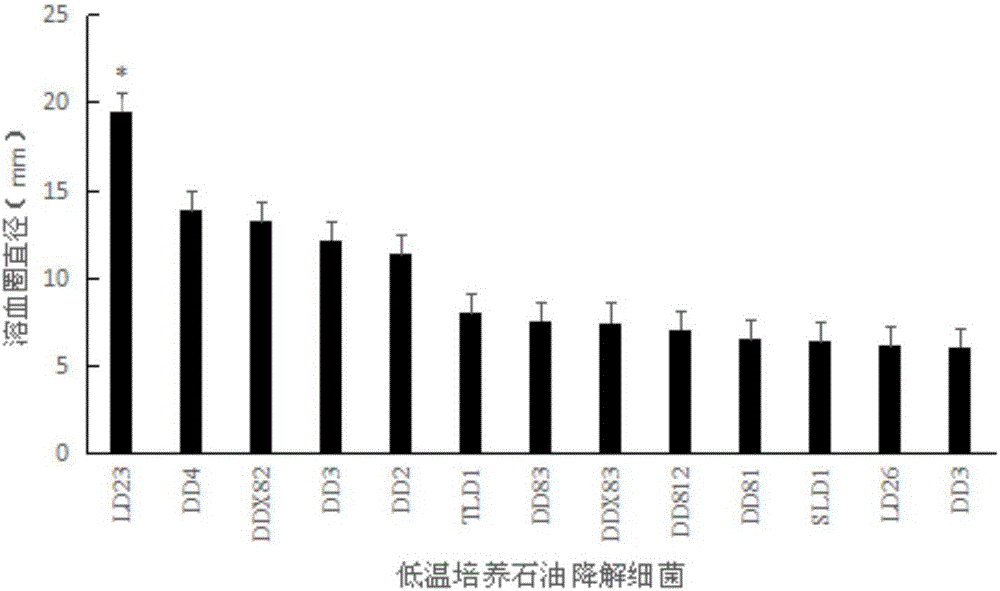Pseudomonas sp. LD23 and preparation of immobilized microspheres of Pseudomonas sp. LD23
A technology of Pseudomonas and microspheres, applied in the field of microorganisms, can solve problems such as lack of research
- Summary
- Abstract
- Description
- Claims
- Application Information
AI Technical Summary
Problems solved by technology
Method used
Image
Examples
Embodiment 1
[0028] This example illustrates strain selection.
[0029] The soil from the representative oil-polluted plots in Daqing was randomly mixed and sieved, and the mixed soil sample was weighed and enriched in the inorganic salt liquid wax medium for enrichment culture; the bacterial solution was drawn and connected to LB solid medium for gradient dilution Cloth, cultivated in a constant temperature incubator at 15°C for 3-5 days. A single colony with good growth was picked for strain purification, and a total of 13 strains of low-temperature bacteria were screened.
[0030] 1 Determination of bacterial growth curve
[0031] Select four representative strains of low-temperature bacteria (LD23, DDX82, DD4 and DD6) with good growth potential, inoculate them in LB liquid medium with 10% inoculum, cultivate them at 15°C, and inoculate them every 12 hours. Bacteria and non-inoculated medium to determine its OD 600 value to draw a growth curve. Such as figure 1 As shown, the select...
Embodiment 2
[0049] This example illustrates the preparation of sodium alginate-activated carbon immobilized microspheres.
[0050] Prepare 45mL of sodium alginate (SA) solution with a certain concentration, add appropriate amount of activated carbon, mix well, and sterilize at 121°C for 25min. Squeeze 5% CaCl into the sterile syringe 2 Formed in solution, cross-linked in a refrigerator at 4°C for a certain period of time, rinsed with normal saline or sterile water for 3 times, and stored in a refrigerator at 4°C to measure physical properties and oil degradation rate (see the table for the proportion of orthogonal experiments for each factor) 1). The prepared immobilized microspheres were added to the petroleum fermentation medium in an amount of 10%, cultured in a shaker at 15°C at 160r / min for 7 days, and then the degradation rate was measured by ultraviolet spectrophotometry, and the method was the same as above.
[0051] By measuring the degradation rate of LD23 petroleum-degrading ...
PUM
| Property | Measurement | Unit |
|---|---|---|
| crush indicators | aaaaa | aaaaa |
Abstract
Description
Claims
Application Information
 Login to View More
Login to View More - R&D
- Intellectual Property
- Life Sciences
- Materials
- Tech Scout
- Unparalleled Data Quality
- Higher Quality Content
- 60% Fewer Hallucinations
Browse by: Latest US Patents, China's latest patents, Technical Efficacy Thesaurus, Application Domain, Technology Topic, Popular Technical Reports.
© 2025 PatSnap. All rights reserved.Legal|Privacy policy|Modern Slavery Act Transparency Statement|Sitemap|About US| Contact US: help@patsnap.com



